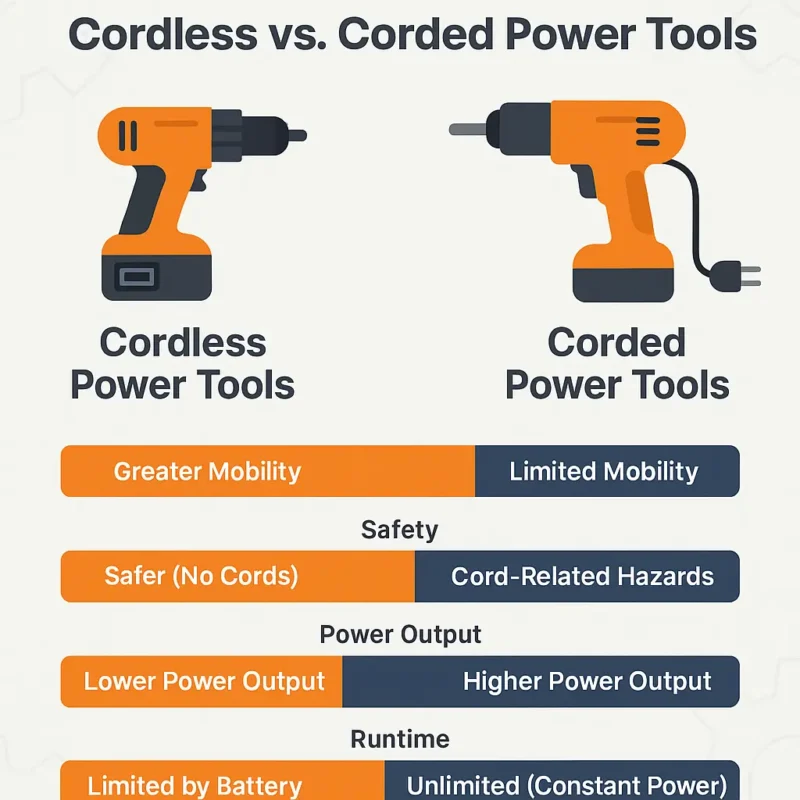Blog
Understanding Cordless Power Tool Technology: Innovations, Benefits, and Future Trends
Cordless power tool technology has transformed how professionals, hobbyists, and homeowners tackle construction, renovation, and repair tasks. Unlike traditional corded tools, cordless options rely on battery-powered systems that enhance flexibility, mobility, and ease of use. The core of this evolution lies in the advancement of lithium-ion battery tools and brushless motor power tools, making cordless solutions both powerful and practical. Understanding cordless power tool technology is vital not only for making informed purchases but also for improving safety, efficiency, and environmental sustainability in various projects. In this comprehensive guide, we’ll explore the evolution, inner workings, benefits, limitations, and future of cordless tools, with a focus on key concepts like lithium-ion battery tools, brushless motor systems, and cordless vs corded tools. Whether you’re a contractor, DIY enthusiast, or someone exploring tool technology for the first time, this guide aims to provide authoritative insights in an accessible and inclusive tone.
The Evolution of Cordless Power Tools

Cordless power tool technology has undergone remarkable transformations over the past few decades. In the early days, power tools were almost exclusively corded, requiring constant connection to an electrical outlet. This not only limited mobility but also posed safety hazards due to tangled cords and limited access in hard-to-reach areas.
Early Developments
The first generation of cordless power tools emerged in the 1960s and 1970s. These tools typically used nickel-cadmium (NiCd) batteries. While revolutionary at the time, NiCd batteries had several drawbacks, including limited energy density, memory effect, and environmental concerns.
Shift to Lithium-Ion Battery Tools
The real game-changer came with the introduction of lithium-ion (Li-ion) battery technology in the 1990s. Lithium-ion batteries offered significantly improved energy density, lighter weight, faster charging times, and a longer lifespan. As a result, lithium-ion battery tools quickly became the industry standard, enabling more powerful and compact cordless devices that rivaled their corded counterparts.
Integration of Brushless Motor Power Tools
In tandem with battery improvements, the development of brushless motor power tools further elevated the performance and reliability of cordless tools. Unlike brushed motors that create friction and wear over time, brushless motors use electronic controllers to adjust power output dynamically, resulting in higher efficiency, less maintenance, and reduced heat generation.
How Cordless Power Tools Work
Understanding how cordless power tools work is essential to appreciating their advantages and making smart decisions when choosing among various models.
Internal Components
At the heart of every cordless tool is a battery, typically a lithium-ion pack, which supplies direct current (DC) to the motor. A control board regulates power distribution and may include safety features like thermal cutoffs and voltage monitoring.
Battery and Charging Systems
Modern lithium-ion battery tools use intelligent battery management systems (BMS) to maximize efficiency and safety. The BMS ensures optimal charging, prevents over-discharge, and balances cells within the battery pack.
Motor Functionality
Brushless motor power tools differ from traditional brushed models by using magnets and electronic control rather than physical brushes. This allows for more efficient energy conversion, longer tool life, and consistent performance under load.
Wireless Connectivity and Smart Features
Many modern cordless power tools now come equipped with Bluetooth or Wi-Fi capabilities. These features allow users to track tool usage, monitor battery life, and even adjust settings remotely using smartphone apps. This digital integration represents the next step in cordless power tool technology.
Advantages of Cordless Power Tools
Cordless power tool technology offers numerous benefits that contribute to its growing popularity among users of all experience levels.
Enhanced Mobility
Without the constraint of a cord, users can move freely around a job site or home, reaching tight spaces and remote areas with ease. This flexibility is particularly valuable in roofing, automotive work, and large-scale installations.
Safety and Ergonomics
Cordless tools reduce the risk of tripping over cords and eliminate the need for extension cables in hazardous environments. Modern designs also focus on ergonomic features like soft grips, balanced weight distribution, and vibration reduction.
Versatility
From drills and saws to sanders and impact drivers, cordless tools are available in nearly every category. Many brands offer interchangeable battery systems, allowing users to power multiple tools with a single battery platform.
Technological Efficiency
The synergy of lithium-ion batteries and brushless motor power tools enhances runtime, torque, and overall performance. This combination ensures tools can perform demanding tasks such as drilling through concrete or cutting thick materials.
Environmental Considerations
Advanced battery technologies reduce the carbon footprint associated with frequent tool replacement and lower energy consumption. Additionally, many manufacturers now offer recycling programs for batteries and components.
Limitations and Considerations
While cordless tools have many strengths, it’s important to be aware of their limitations and practical considerations.
Battery Life and Charging Time
Despite advances in lithium-ion technology, battery runtime still varies based on tool type, usage intensity, and environmental conditions. Users may need multiple batteries or backup charging solutions to avoid downtime.
Initial Cost
Cordless power tools often have a higher upfront cost compared to corded alternatives, particularly when purchasing kits that include batteries and chargers. However, the long-term value often justifies the investment.
Power Output
Some high-powered tasks may still be better suited to corded tools, especially when continuous performance is required. While brushless motor power tools narrow the gap, they haven’t completely replaced heavy-duty corded machines.
Battery Maintenance
To prolong battery life, users must follow best practices such as avoiding full discharges, storing batteries in cool, dry places, and using manufacturer-recommended chargers.
Cordless vs. Corded Tools: Making the Right Choice
When choosing between cordless vs corded tools, it’s crucial to evaluate your specific needs, frequency of use, and work environment.
Use Case Scenarios
Cordless tools excel in situations requiring mobility, such as outdoor construction or interior work without convenient outlets. Corded tools, however, are ideal for continuous use in workshops or when maximum power is needed.
Cost Analysis
While cordless tools require an upfront investment, they can offer better returns over time due to increased productivity and reduced setup time. Corded tools are often more economical for stationary or occasional use.
Performance Considerations
Thanks to brushless motor power tools and high-capacity lithium-ion batteries, the performance gap is closing. For most users, cordless tools now meet or exceed expectations across a wide range of applications.
User Preferences
Comfort, convenience, and familiarity often influence tool choice. Some users prefer the consistency of corded power, while others prioritize the freedom and innovation offered by cordless solutions.
Innovations in Battery Technology
Battery technology is the engine behind cordless power tool evolution. Recent innovations continue to drive efficiency, sustainability, and performance.
Lithium-Ion Advancements
Modern lithium-ion cells offer higher energy density, faster charge cycles, and greater durability( e.g., the FlagTools 21V Brushless Drill ). Some brands use custom chemistries to optimize specific parameters like weight or heat tolerance.
Smart Battery Systems
New batteries integrate diagnostic tools, LED indicators, and app-based tracking. These smart systems monitor temperature, charge level, and usage patterns, enhancing reliability and user experience.
Sustainability and Recycling
Manufacturers are investing in environmentally responsible battery production and recycling. Programs like battery take-backs and closed-loop manufacturing reduce waste and support circular economies.
Future Technologies
Emerging innovations such as solid-state batteries promise even greater capacity, safety, and charge efficiency. These developments will likely redefine cordless power tool technology in the coming decade.
The Future of Cordless Power Tools
The future of cordless power tool technology is promising, driven by trends in electrification, digital integration, and sustainable manufacturing.
Greater Efficiency
Expect continuous improvements in brushless motor efficiency, battery optimization, and power management. Tools will become smarter, lighter, and more adaptive to user behavior.
IoT and Connectivity
Integrated connectivity will enable real-time diagnostics, cloud-based tool management, and predictive maintenance. Contractors will benefit from fleet tracking and data analytics to improve productivity.
Eco-Friendly Designs
Sustainability will play a larger role, with tools made from recycled materials, energy-efficient components, and packaging designed to reduce environmental impact.
User-Centric Innovation
Manufacturers are focusing on inclusive design, offering lighter tools, customizable grips, and features that address diverse user needs, including those with limited strength or mobility.
Conclusion
Understanding cordless power tool technology provides users with the knowledge to make informed decisions based on functionality, cost, and long-term value. From the evolution of lithium-ion battery tools to the rise of brushless motor power tools and the debate over cordless vs corded tools, today’s innovations offer powerful, sustainable, and user-friendly solutions. Whether you’re a professional contractor or weekend DIYer, embracing these technologies empowers you to work smarter, safer, and more efficiently.









